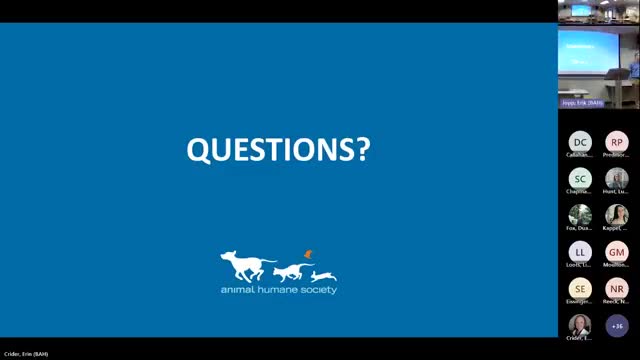Minnesota Animal Health Board Seeks Budget Approval for Emergency Preparedness Funding
April 03, 2024 | Board of Animal Health, Agencies, Boards, & Commissions, Executive, Minnesota

This article was created by AI summarizing key points discussed. AI makes mistakes, so for full details and context, please refer to the video of the full meeting. Please report any errors so we can fix them. Report an error »

In a meeting filled with critical discussions about funding and operational strategies, the Minnesota Board of Animal Health convened on April 3, 2024, to address pressing issues affecting animal health management in the state. As board members gathered, the atmosphere was charged with a sense of urgency, particularly regarding the financial landscape that shapes their work.
The meeting kicked off with a focus on the board's budget, which operates on a biennial cycle. The board has been allocated $6.24 million for the current fiscal year, with specific mandates to utilize $200,000 for agricultural emergency preparedness. This funding is crucial as the board navigates challenges such as avian influenza and chronic wasting disease, which have significant implications for both animal and public health.
A key point of discussion was the need for additional funding to ensure compliance with evolving health standards. Board members expressed appreciation for the support received but emphasized the necessity of securing more resources to effectively manage their responsibilities. The conversation highlighted the delicate balance between fiscal constraints and the imperative to maintain high standards of animal health.
The board's financial report revealed that approximately $4.5 million of the state general appropriation has already been expended, with a significant portion directed towards emergency response efforts. However, the board is facing a decline in revenue from certain programs, particularly following the transfer of whitetail deer management responsibilities to the Department of Natural Resources. This shift has resulted in a projected loss of $50,000 to $60,000 in fees, raising concerns about the board's future financial stability.
As the meeting progressed, members discussed the challenges of staffing within the agency. With a high demand for services and ongoing vacancies, the board has made strides in hiring new personnel since early 2023. However, the struggle to attract and retain qualified staff remains a pressing issue, compounded by rising salary costs that exceed initial budget projections.
In conclusion, the April meeting of the Minnesota Board of Animal Health underscored the complexities of managing animal health in a financially constrained environment. As the board looks ahead, the need for strategic funding and effective resource management will be paramount in ensuring the health and safety of Minnesota's animal populations. The discussions held during this meeting will undoubtedly shape the board's approach as they navigate the challenges of the coming fiscal year.
The meeting kicked off with a focus on the board's budget, which operates on a biennial cycle. The board has been allocated $6.24 million for the current fiscal year, with specific mandates to utilize $200,000 for agricultural emergency preparedness. This funding is crucial as the board navigates challenges such as avian influenza and chronic wasting disease, which have significant implications for both animal and public health.
A key point of discussion was the need for additional funding to ensure compliance with evolving health standards. Board members expressed appreciation for the support received but emphasized the necessity of securing more resources to effectively manage their responsibilities. The conversation highlighted the delicate balance between fiscal constraints and the imperative to maintain high standards of animal health.
The board's financial report revealed that approximately $4.5 million of the state general appropriation has already been expended, with a significant portion directed towards emergency response efforts. However, the board is facing a decline in revenue from certain programs, particularly following the transfer of whitetail deer management responsibilities to the Department of Natural Resources. This shift has resulted in a projected loss of $50,000 to $60,000 in fees, raising concerns about the board's future financial stability.
As the meeting progressed, members discussed the challenges of staffing within the agency. With a high demand for services and ongoing vacancies, the board has made strides in hiring new personnel since early 2023. However, the struggle to attract and retain qualified staff remains a pressing issue, compounded by rising salary costs that exceed initial budget projections.
In conclusion, the April meeting of the Minnesota Board of Animal Health underscored the complexities of managing animal health in a financially constrained environment. As the board looks ahead, the need for strategic funding and effective resource management will be paramount in ensuring the health and safety of Minnesota's animal populations. The discussions held during this meeting will undoubtedly shape the board's approach as they navigate the challenges of the coming fiscal year.
View full meeting
This article is based on a recent meeting—watch the full video and explore the complete transcript for deeper insights into the discussion.
View full meeting
